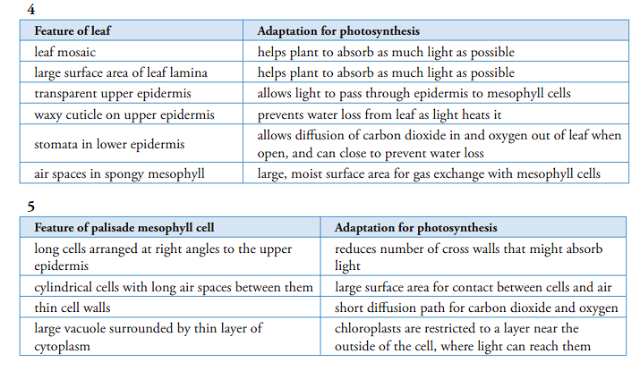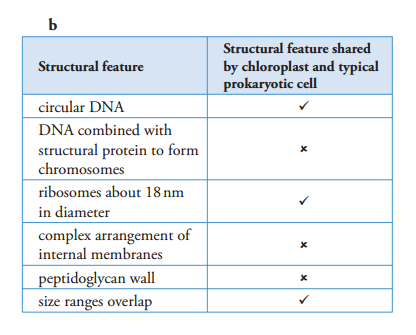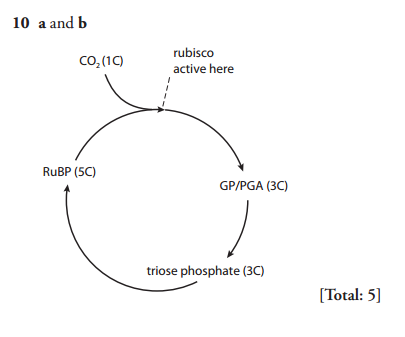Biology
 1 In photosynthesis, light energy is absorbed by chlorophyll pigments and converted to chemical energy, which is used to produce complex organic molecules.
1 In photosynthesis, light energy is absorbed by chlorophyll pigments and converted to chemical energy, which is used to produce complex organic molecules.
2 In the light-dependent reactions, water is split by photolysis to give hydrogen ions, electrons and oxygen. The hydrogen ions and electrons are used to reduce the carrier molecule, NADP, and the oxygen is given off as a waste product.
3 ATP is synthesised in the light-dependent reactions of cyclic and non-cyclic photophosphorylation. During these reactions the photosynthetic pigments of the chloroplast absorb light energy and give out excited electrons. Energy from the electrons is used to synthesise ATP.
4 ATP and reduced NADP are the two main products of the light-dependent reactions of photosynthesis, and they then pass to the light-independent reactions.
5 In the light-independent reactions, carbon dioxide is trapped by combination with a 5C compound, RuBP, which acts as an acceptor molecule. This reaction is catalysed by the enzyme ribulose bisphosphate carboxylase (rubisco), which is the most common enzyme in the world. The resulting 6C compound splits to give two molecules of a 3C compound, GP (also known as PGA). GP is reduced to carbohydrate, using ATP and reduced NADP from the light-dependent reactions. This carbohydrate can be converted into other carbohydrates, amino acids and lipids or used to regenerate RuBP. This sequence of light-independent events is called the Calvin cycle.
6 Chloroplasts, palisade mesophyll cells and whole leaves are all adapted for the efficient absorption of light for the process of photosynthesis.
7 When a process is affected by more than one factor, the rate of the process will be limited by the factor closest to its lowest value. The rate of photosynthesis is subject to various such limiting factors, including light intensity and wavelength, carbon dioxide concentration and temperature.
8 A graph of the particular wavelengths of light that are absorbed by a photosynthetic pigment is called an absorption spectrum, and a graph of the rate of photosynthesis at different wavelengths of light is called an action spectrum.
9 The different pigments present in a chloroplast can be separated by paper chromatography.
1. End-of-chapter questions
1 What are the products of the light-dependent reactions of photosynthesis?
A ATp, RuBP and reduced NAD
B ATp, oxygen and reduced NADP
C GP, oxygen and reduced NAD
D GP, reduced NADP and RuBP
2 Where in the chloroplast are the products of photophosphorylation used?
A envelope
B granum
C stroma
D thylakoid
3 In separate experiments, an actively photosynthesising plant was supplied with one of two labelled reactants:
? water containing the 18O
In which products of photosynthesis would these isotopes be found?

4 Copy and complete the table to how the adaptations of a dicotyledonous leaf for photosynthesis. The first row has been competed for you.

5 Copy and complete the table to show the adaptations of a palisade mesophyll cell for photosynthesis.

6 Rearrange the following statements to make a flow diagram of the mechanism of opening a stoma.
1. volume of guard cell increases
2. H+ transported out of guard cells
3. water enters guard cells by osmosis
4. K+ diffuses into guard cells
5. guard cells curve to open stoma
6. water potential of guard cells falls
7. K+ channels open
7 a Explain how the inner membrane system of a chloroplast makes it well adapted for photosynthesis.
b Copy the table below and insert ticks or crosses to show which structural features are shared by a plant chloroplast and a typical prokaryotic cell.


- #103 The Light-independent Reactions (calvin Cycle)
The light-independent reactions take place in the stroma of the chloroplast, where the enzyme ribulose bisphosphate carboxylase, usually known as rubisco, is found. 1. Carbon fixation CO2 diffuses into the stroma from the air spaces within the...
- # 102 The Light-dependent Reactions, Photophosphorilation
Chlorophyll molecules in photosystern I (PSI) and photosystern II (PSII) absorb light energy. The energy excites electrons, raising their energy level so that they leave the chlorophyll. The chlorophyll is said to be photo-activated. PSII contains...
- #100 Chloroplasts
Photosynthesis takes place inside chloroplasts. These are organelles surrounded by 2 membranes, called an envelope. Chloroplasts are found in mesophyll cells in leaves: - Palisade mesophyll cells contain most chloroplasts. - Spongy...
- #99 Photosynthesis Overview
Photosynthesis is a series of reactions in which energy transferred as light is transformed to chemical energy. Energy from light is trapped by chlorophyll, and this energy is then used to ? split apart the strong bonds in water molecules to release...
- #98 Photosynthesis Syllabus
13.1 Photosynthesis as an energy transfer process 13.2 Investigation of limiting factors 13.3 Adaptations for photosynthesis Photosynthesis is the energy transfer process that is the basis of much of life on Earth....
Biology
#106 Summary of Photosynthesis

2 In the light-dependent reactions, water is split by photolysis to give hydrogen ions, electrons and oxygen. The hydrogen ions and electrons are used to reduce the carrier molecule, NADP, and the oxygen is given off as a waste product.
3 ATP is synthesised in the light-dependent reactions of cyclic and non-cyclic photophosphorylation. During these reactions the photosynthetic pigments of the chloroplast absorb light energy and give out excited electrons. Energy from the electrons is used to synthesise ATP.
4 ATP and reduced NADP are the two main products of the light-dependent reactions of photosynthesis, and they then pass to the light-independent reactions.
5 In the light-independent reactions, carbon dioxide is trapped by combination with a 5C compound, RuBP, which acts as an acceptor molecule. This reaction is catalysed by the enzyme ribulose bisphosphate carboxylase (rubisco), which is the most common enzyme in the world. The resulting 6C compound splits to give two molecules of a 3C compound, GP (also known as PGA). GP is reduced to carbohydrate, using ATP and reduced NADP from the light-dependent reactions. This carbohydrate can be converted into other carbohydrates, amino acids and lipids or used to regenerate RuBP. This sequence of light-independent events is called the Calvin cycle.
6 Chloroplasts, palisade mesophyll cells and whole leaves are all adapted for the efficient absorption of light for the process of photosynthesis.
7 When a process is affected by more than one factor, the rate of the process will be limited by the factor closest to its lowest value. The rate of photosynthesis is subject to various such limiting factors, including light intensity and wavelength, carbon dioxide concentration and temperature.
8 A graph of the particular wavelengths of light that are absorbed by a photosynthetic pigment is called an absorption spectrum, and a graph of the rate of photosynthesis at different wavelengths of light is called an action spectrum.
9 The different pigments present in a chloroplast can be separated by paper chromatography.
Video: Photosynthesis
1. End-of-chapter questions
1 What are the products of the light-dependent reactions of photosynthesis?
A ATp, RuBP and reduced NAD
B ATp, oxygen and reduced NADP
C GP, oxygen and reduced NAD
D GP, reduced NADP and RuBP
2 Where in the chloroplast are the products of photophosphorylation used?
A envelope
B granum
C stroma
D thylakoid
3 In separate experiments, an actively photosynthesising plant was supplied with one of two labelled reactants:
? water containing the 18O
In which products of photosynthesis would these isotopes be found?

4 Copy and complete the table to how the adaptations of a dicotyledonous leaf for photosynthesis. The first row has been competed for you.


1. volume of guard cell increases
2. H+ transported out of guard cells
3. water enters guard cells by osmosis
4. K+ diffuses into guard cells
5. guard cells curve to open stoma
6. water potential of guard cells falls
7. K+ channels open
b Copy the table below and insert ticks or crosses to show which structural features are shared by a plant chloroplast and a typical prokaryotic cell.

8 a When isolated chloroplasts are placed in buffer solution with a blue dye such as DCPIP or methylene blue and illuminated, the blue colour disappears. Explain this observation.
[4]
b Name the compound, normally present in photosynthesis, that is replaced by the blue dye in this investigation. [1]
[Total: 5]
9 Distinguish between:
a cyclic and non-cyclic photophosphorylation [2]
b photophosphorylation and oxidative phosphorylation [2]
c the roles of NAD and NADP in a plant. [2]
[Total: 6]
10 a Draw a simple flow diagram of the Calvin cycle to show the relative positions in the cycle of the following molecules:
? CO2 (IC)
? GP/PGA (3C)
? triose phosphate (3C)
? RuBP (5C). [4]
b Show the point in the cycle at which the enzyme rubisco is active. [1]
[Total: 5]
11 a Explain what is meant by a limiting factor.
b List four factors that may be rate-limiting in photosynthesis.
c At low light intensities, increasing the temperature has little effect on the rate of photosynthesis.
At high light intensities, increasing the temperature increases the rate of photosynthesis.
Explain these observations. [5]
[Total: 10]
12 a Distinguish between an absorption spectrum and an action spectrum. [4]
b Pondweed was exposed to each of three different wavelengths of light for the same length of time. For each wavelength, the number of bubbles produced from the cut ends of the pondweed were counted and are shown in the table.

Explain these results. [4]
[Total: 8]
2. End-of-chapter answers
1 B
2 C
3 A

6 2, 7, 4, 6, 3, 1, 5
All correct = 4, subtract marks for mistakes.
7 a allows chlorophyll and other pigments to be arranged into photosystems;
provides large surface area for pigments;
increases effi ciency of light harvesting; allows electron carriers to be arranged appropriately; provides structure for proton gradient for chemiosmosis; anchors ATP synthase;

Exam-style questions

8 a photolysis of water occurs in light;
H+ released; accepted by DCPIP/methylene blue;
colourless when reduced;
shows ?reducing power? of chloroplasts; [max. 4]
b NADP; [1]
9 a cyclic photophosphorylation: electron emitted by chlorophyll of photosystem I returns to chlorophyll by a series of carriers;
non-cyclic photophosphorylation: electron emitted by chlorophyll of photosystem II does not return to that chlorophyll (but is absorbed by photosystem I and electron emitted by photosystem I is absorbed by NADP); [2]
b photophosphorylation: synthesis of ATP using light energy in photosynthesis in a chloroplast; oxidative phosphorylation: synthesis of ATP using energy released from the electron transport chain in aerobic respiration in a mitochondrion; [2]
c NAD: hydrogen carrier in respiration; NADP: hydrogen carrier in photosynthesis; [2]

2 C
3 A

All correct = 4, subtract marks for mistakes.
7 a allows chlorophyll and other pigments to be arranged into photosystems;
provides large surface area for pigments;
increases effi ciency of light harvesting; allows electron carriers to be arranged appropriately; provides structure for proton gradient for chemiosmosis; anchors ATP synthase;

Exam-style questions

8 a photolysis of water occurs in light;
H+ released; accepted by DCPIP/methylene blue;
colourless when reduced;
shows ?reducing power? of chloroplasts; [max. 4]
b NADP; [1]
[Total: 5]
9 a cyclic photophosphorylation: electron emitted by chlorophyll of photosystem I returns to chlorophyll by a series of carriers;
non-cyclic photophosphorylation: electron emitted by chlorophyll of photosystem II does not return to that chlorophyll (but is absorbed by photosystem I and electron emitted by photosystem I is absorbed by NADP); [2]
b photophosphorylation: synthesis of ATP using light energy in photosynthesis in a chloroplast; oxidative phosphorylation: synthesis of ATP using energy released from the electron transport chain in aerobic respiration in a mitochondrion; [2]
c NAD: hydrogen carrier in respiration; NADP: hydrogen carrier in photosynthesis; [2]
[Total: 6]

11 a limiting factor: one factor, of many aff ecting a process, that is nearest its lowest value and hence is rate-limiting; [1]
b light intensity; light wavelength; concentration of carbon dioxide; temperature; [4]
c shows that there are two sets of reaction in photosynthesis;
a light-dependent photochemical stage;
a light-independent temperature-dependent stage;
photochemical reactions are not aff ected by temperature; at low light intensities, light intensity is the ratelimiting factor;
at high light intensities and low temperatures, temperature is the rate-limiting factor; [max. 5]
[Total: 10]
12 a absorption spectrum: a graph of the absorbance of diff erent wavelengths of light by a compound; action spectrum: a graph of the rate of a process, e.g. photosynthesis at diff erent wavelengths of light; [4] b number of bubbles shows rate of photosynthesis; rate similar at 450 nm (blue) and 650 nm (red); these are wavelengths that are absorbed by chlorophyll; rate, much lower/refer to fi gures, at 550 nm (green); very little absorbed by any pigment; [max. 4]
[Total: 8]
- #103 The Light-independent Reactions (calvin Cycle)
The light-independent reactions take place in the stroma of the chloroplast, where the enzyme ribulose bisphosphate carboxylase, usually known as rubisco, is found. 1. Carbon fixation CO2 diffuses into the stroma from the air spaces within the...
- # 102 The Light-dependent Reactions, Photophosphorilation
Chlorophyll molecules in photosystern I (PSI) and photosystern II (PSII) absorb light energy. The energy excites electrons, raising their energy level so that they leave the chlorophyll. The chlorophyll is said to be photo-activated. PSII contains...
- #100 Chloroplasts
Photosynthesis takes place inside chloroplasts. These are organelles surrounded by 2 membranes, called an envelope. Chloroplasts are found in mesophyll cells in leaves: - Palisade mesophyll cells contain most chloroplasts. - Spongy...
- #99 Photosynthesis Overview
Photosynthesis is a series of reactions in which energy transferred as light is transformed to chemical energy. Energy from light is trapped by chlorophyll, and this energy is then used to ? split apart the strong bonds in water molecules to release...
- #98 Photosynthesis Syllabus
13.1 Photosynthesis as an energy transfer process 13.2 Investigation of limiting factors 13.3 Adaptations for photosynthesis Photosynthesis is the energy transfer process that is the basis of much of life on Earth....
